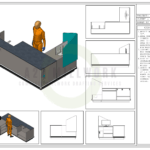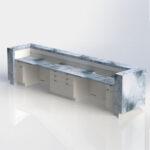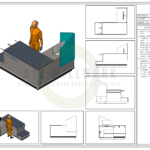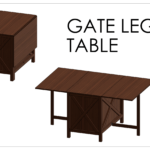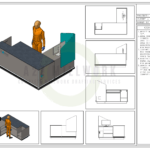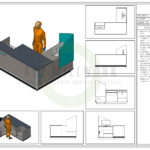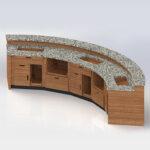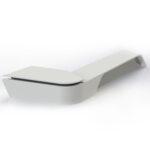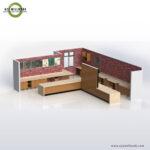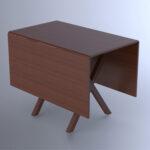Estimate millwork for a design-build project is a meticulous process that requires a deep understanding of the project scope, materials, labor, and various other factors. Accurate estimation ensures the project stays within budget and meets the client’s expectations. This article will provide a comprehensive guide on estimate millwork for a design-build project, leveraging insights and methodologies from the industry.
Understanding the Scope of Work
The first and most critical step in estimating millwork is understanding the project’s scope. This involves a thorough review of architectural plans, design specifications, and any details provided by the client. Key elements to consider include:
- Types of Millwork: Identify the types of millwork required, such as cabinetry, trim, moldings, doors, windows, and paneling. Each type of millwork has distinct material and labor needs.
- Design Complexity: Assess the complexity of the designs. Intricate details, custom carvings, and unique finishes will require more skilled labor and time, affecting the overall cost.
- Quantity and Dimensions: Accurately measure the quantity and dimensions of each millwork component. These measurements are crucial for calculating material quantities and labor hours.
Material Selection and Costs
Material selection plays a significant role in the overall cost of millwork. Different materials come with varying price points and properties. Consider the following factors when estimating material costs:
- Wood Species: The type of wood used affects both the material cost and the labor required. Common choices include oak, maple, cherry, and walnut, each with its unique cost and characteristics.
- Sheet Goods and Veneers: For cabinetry and paneling, consider the cost of sheet goods such as plywood, MDF, and veneers. High-quality veneers and laminates can add to the cost but provide a premium finish.
- Hardware and Accessories: Include the cost of hardware such as hinges, handles, drawer slides, and other accessories. High-quality hardware enhances functionality and durability, impacting the overall cost.
Labor Costs
Labor costs are a significant component of millwork estimation. Skilled labor is essential for producing high-quality millwork, and the complexity of the design will impact the labor hours required. Consider the following when estimating labor costs:
- Fabrication Time: Estimate the time required for fabricating each millwork component. Complex designs and custom details will require more time and skilled craftsmanship.
- Installation Time: Factor in the time needed for installation. This includes on-site measurements, fitting, and finishing. The complexity of the site conditions can also affect installation time.
- Labor Rates: Consider the hourly rates of the craftsmen involved. Skilled carpenters and joiners typically command higher rates due to their expertise and experience.
Overhead and Profit
In addition to material and labor costs, it’s essential to account for overhead and profit. Overhead includes indirect costs such as shop expenses, utilities, insurance, and administrative costs. Profit margins vary by company but typically range from 10% to 20%. Ensure these factors are included in the final estimate to cover all business expenses and ensure profitability.
Detailed Breakdown and Contingencies
Provide a detailed breakdown of all costs in the estimate. This transparency helps clients understand where their money is going and builds trust. Include contingencies to account for unforeseen issues or changes in project scope. A common practice is to add a 5% to 10% contingency to the total estimate to cover unexpected costs.
Utilizing Estimation Software
Leveraging estimation software can enhance accuracy and efficiency in the millwork estimation process. Tools like Microvellum, Cabinet Vision, and Cut Rite can help streamline material takeoffs, labor calculations, and cost breakdowns. These software solutions integrate with CAD designs and provide detailed reports, making the estimation process more accurate and professional.
Steps to Estimate Millwork for a Design-Build Project
- Review Project Documents: Gather all necessary documents, including architectural plans, design specifications, and client requirements. Review these documents thoroughly to understand the scope of the project.
- Conduct Site Visits: If possible, visit the project site to take accurate measurements and assess site conditions. This step is crucial for understanding the installation environment and identifying any potential challenges.
- Create Detailed Drawings: Use CAD software to create detailed drawings of the millwork components. These drawings should include precise measurements, material specifications, and design details.
- Calculate Material Quantities: Based on the detailed drawings, calculate the quantities of materials required. Include wood species, sheet goods, veneers, hardware, and accessories in your calculations.
- Estimate Labor Hours: Determine the labor hours required for fabrication and installation. Consider the complexity of the designs, the skills of the craftsmen, and the site conditions.
- Factor in Overhead and Profit: Include overhead costs and desired profit margins in your estimate. Overhead costs should cover indirect expenses such as shop expenses, utilities, insurance, and administrative costs.
- Add Contingencies: Include a contingency percentage in your estimate to account for unforeseen issues or changes in project scope. A common practice is to add a 5% to 10% contingency to the total estimate.
- Prepare a Detailed Cost Breakdown: Provide a detailed breakdown of all costs in your estimate. This should include material costs, labor costs, overhead, profit, and contingencies. Transparency in your cost breakdown helps build trust with the client.
Real-World Example of Millwork Estimation
To illustrate the process, let’s consider an example of estimate millwork for a custom kitchen project. The project includes cabinetry, crown moldings, and a kitchen island.
- Scope of Work:
- Custom cabinetry: 10 linear feet of base cabinets, 15 linear feet of upper cabinets
- Crown moldings: 30 linear feet
- Kitchen island: 5×3 feet with custom finishes
- Material Selection and Costs:
- Wood species: Maple
- Sheet goods: Plywood for cabinet boxes, MDF for doors
- Hardware: Soft-close hinges, drawer slides, handles
- Labor Costs:
- Fabrication time: 80 hours (based on design complexity)
- Installation time: 40 hours
- Labor rates: $50/hour
- Overhead and Profit:
- Overhead: 15% of total material and labor costs
- Profit: 20% of total material and labor costs
- Contingencies:
- 5% of total estimate
Conclusion
Estimating millwork for a design-build project involves a detailed analysis of the scope of work, material selection, labor costs, overhead, profit, and contingencies. Accurate estimates are crucial for staying within budget and ensuring project success. Utilizing estimation software can enhance precision and efficiency, making the process more streamlined.
A2Z Millwork Design LLC is a leading provider of millwork estimation and design services. Specializing in Microvellum shop drawings and custom millwork solutions, We ensure that your projects are executed with precision and excellence. With a focus on quality and customer satisfaction, A2Z Millwork Design LLC is your trusted partner for all your millwork needs in the USA. For more information, visit A2ZMillwork Design LLC..


